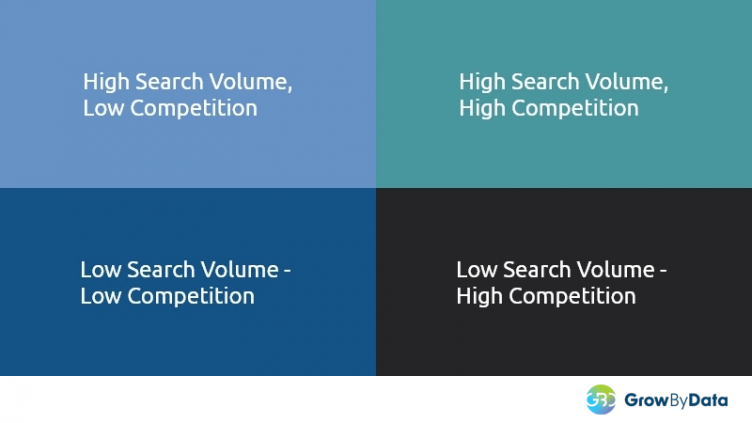Google is constantly working on updating its algorithm to give the best results to users. It tries to connect users with the most relevant and high-quality content. Keywords are one of the most crucial aspects of creating high-quality content that shows up on search queries.
In this article, we guide marketers through the process of performing comprehensive keyword planning and creating data-driven marketing strategies that win.
Table of Contents: Show
What is meant by Keyword Planning?
Keyword planning is the process of finding relevant search queries and keywords for your brand, product, and services. This strategy helps to develop a holistic search strategy to gain traffic from search engines.
People use keywords to find solutions when researching online. So, if your content is successful in gaining their attention then you stand a chance of getting more traffic.
Why is Keyword Planning important?
Keyword planning is one of the most important aspects of search marketing strategy. A potential customer uses various search terms to find answers to their problems in search engines. It helps to gather a pool of highly searched queries to develop an advertising strategy to acquire consistent search traffic from search engines.
For effective search marketing, both SEO and SEM practitioners need to conduct thorough keyword research. A systematic data-driven keyword planning lays out the roadmap for successful paid and organic campaigns.
Below are the benefits of Comprehensive Keyword Planning:
- Increase your keyword universe
- The target audience of different funnel stages
- Find your opportunity keywords
- Understand your competitors and their keywords
- Understand the keyword gap with competitors
- Understand the keyword search intent
- Find which keyword to target for various SERP features
- Create a data-driven content strategy and prioritization
Process of Comprehensive Keyword Planning
Keywords are the core aspect of SEO, SEM, content marketing, and link-building campaigns. The process of keyword planning is a must to identify any relevant, high/low competitive, and conversion keywords for targeting all your customers in different stages of their buying journey. Therefore, keyword planning should go through various processes from identifying all relevant queries to mapping the intent of those queries with your customer journey.
Below are the stages of effective and comprehensive keyword planning to build a roadmap for a successful Search Marketing Strategy.
1. Building Keyword Pool
The first stage of keyword planning is to gather all important search queries relevant to your business. Below are a few steps to gather relevant search queries.
1.a. List out all relevant keywords
Analyzing your business is the first step to finding the keywords. List out any keywords that define your brand, products, or any kind of service. It means figuring out different ways your customers will be searching for your business. This is the foundation of keyword planning and every other step will take the result of this step to further build your keywords pool.
1.b. Add Keywords from Search Engines itself
To further expand your keywords pool, collect all auto-suggestions and related keywords for each of the primary keywords you have listed in the first step.
- Auto Suggestion Keywords
Whenever users enter a search term in the search box, search engines like Google provides a list of auto-suggestion keywords based on that search term. Those auto-suggestion keywords are basically the list of search queries that users have used in that Search Engine. These days all popular search engines like Google, Bing, Amazon, and others all have this feature which has helped both searchers and marketers to identify the right search term for their respective causes.


1.c. Add Competitor Keywords in the Pool
Another way to find more keywords is by discovering your key competitors and analyzing the keywords they are targeting. GrowByData Search Intelligence Solutions can help you discover both paid and organic competitors and with tools like keyword planner, you can generate other keywords those competitors are getting ranked. Based on this you can pick more relevant keywords to target.

1.d. Question Keywords from People Also Ask
Another source of keywords is People Also Ask features from search engines. Question keywords serve as long-tail keywords to target users who are basically in the early stage of their buying journey. Basically, these keywords and the SERP feature are targeting information-seeking users who typically are in their research phase.

2. Keyword Funneling with SERP Analysis
Now you have all the possible keywords that your users can use to find your business in search engines. The next step is to map those keywords into different funnel stages and the intent of users.
2. a. Keyword and SERP Intent Mapping
SERP Intent Analysis basically helps you understand the intent of a keyword through the search results. If organic search results in the SERP are presenting more informational content the SERP basically indicates the keyword intent is informational.
It basically means the search queries are typically used by customers who fall into the awareness/research phase of the marketing funnel. Information like this helps you plan, the kind of content to target for any keyword. This step helps you categorize keywords into Awareness/Research, Consideration, and Conversion stages.

For example, The long tail keyword “best outdoor wireless camera” shows 9 informational results/blog articles. This implies that the search engine is considering the search intent as “information/research”. To compete with competitors and to win clicks with intent matching, you should consider information content for this keyword.
Read Here: Competitive SERP Analysis in 2023
2.b. Identify SERP Feature Availability
Certainly, matching the intent is the primary objective however these days there are multiple search features available in SERP that target customers at different stages of their buying journey. Search Engines like Google are basically looking to optimize the SERP CTR and show content to address the needs of customers in different stages of their journey. Therefore, as a Search Marketer, you should understand this factor and keep note of it in our keyword planning process i.e., you must understand what type of SERP features are appearing for any specific keyword.
For example: If SERP is showing feature snippets and PAA which basically are informational content, you should be looking to optimize page content for these SERP components as well despite the keyword’s primary intent being transactional.

In fig 8, you can see what types of SERP features are showing for each keyword. The Keyword “price optimization” is showing 6 SERP Features in SERPs. You can create a content strategy based on SERP features availability. However, if you want to target “Text Ads”, you need to target the bottom of the funnel. But if you want to target People also Ask or Google Featured Snippets, you need to create content targeting the bottom or middle of the funnel.
3. Keyword Prioritization
Until now you have identified all the relevant keywords and kinds of content you need to prepare to target for each of the keywords. Now the last phase of the keyword planning process is to prioritize keywords. This step basically plots the roadmap for search strategy i.e., which keywords and contents to target for maximum efficiency.
There are many factors to consider when you create a search marketing roadmap for your keywords such as Keyword volume, Competition, Competitive SERP relevance, and Authoritative score to identify opportunity keywords in a strategic order to lay out an efficient roadmap for success and efficient search marketing.
3.a Keyword Search Volume and Competition
To prioritize keywords first step is to understand the average search volume and competitiveness of that keyword as shown in the figure below.
The High Volume and Low Competition keywords basically should be your priority keyword pool as there is low competition and you could get a lot more traffic with lower cost and effort.
The next keyword pool is to target High Search Volume and High Competition keywords simply because it has high search volume and as a marketer, you need to analyze the opportunity to get ranked in these keywords. The competitive relevancy and authoritative score analysis help you further categorize and prioritize these keywords.
The low search volume and low competition keywords should be your next priority keywords and high competition keywords are something you can ignore.

The Relevance score basically means the keyword strings match the percentage of the ad contents competing in the SERP. It is an important component for your, keyword quality score logic of Search Engines like Google. The higher the relevancy score the chances of getting ranked or outranked the lower the relevancy score and the content are. Therefore, you need to add these metrics to your keyword prioritization process and identify the fastest gateway to rank higher in the SERP.
The authoritative score basically means how credible the information provided by the website is for any search query. It is basically measured based on domain authority and page authority. Domain authority is the credibility of an entire domain while page authority is the credibility of that individual page competing in the SERP. Based on the competitive authoritative score analytics between you and your SERP competitors you should be able to identify opportunity and striking distance keywords to win ranking in each keyword SERP. SERP has competitors with low authoritative scores than yours means you have a very high opportunity to win ranking in that SERP.
Therefore, you should categorize your keywords into these competitive scoring for final prioritizing of selected keywords from the above step to lay step-by-step keywords and content strategy for successful search marketing campaigns.

Conclusion
The comprehensive keyword planning guide not only gives you a huge set of relevant keywords, and content to target but also lays out a detailed roadmap for efficient search marketing campaigns.



